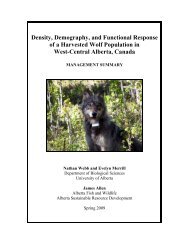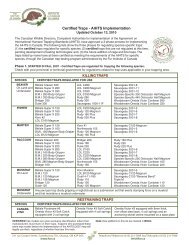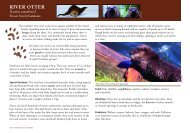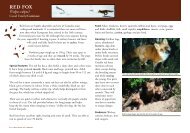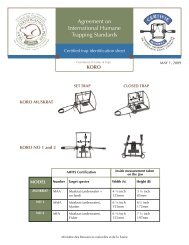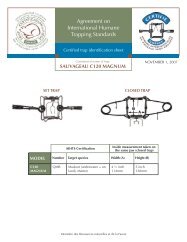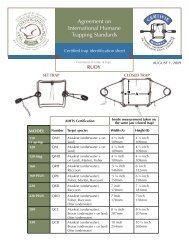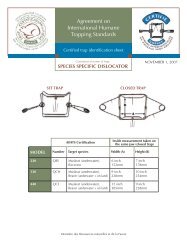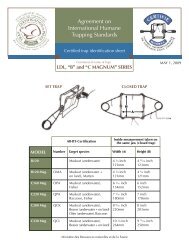Survival Rate of Released Mink Study - Animal Liberation Front
Survival Rate of Released Mink Study - Animal Liberation Front
Survival Rate of Released Mink Study - Animal Liberation Front
You also want an ePaper? Increase the reach of your titles
YUMPU automatically turns print PDFs into web optimized ePapers that Google loves.
1688 T. Maran et al. / Biological Conservation 142 (2009) 1685–1692Table 2<strong>Mink</strong> radio-tracked in 2000–2003. Maximum survival time – known from yearly live-trapping census following the release operation. These data are not included in the analysisfor the sake <strong>of</strong> consistency in measuring methods. Average T - Number <strong>of</strong> generations in captivity. Status – <strong>Mink</strong> with the following status were censored: Lost – signal lost; Alive– alive at the end <strong>of</strong> radio-tracking; Collar – radio-collar lost.ID Sex Pregnant Birth date Release date Last recordedsignal<strong>Survival</strong> time(radio-tracking)Maximumsurvival timeEnclosuretypeAge Average T Status686 Female No 09.06.1999 28.06.2000 7.07.2000 9 9 Small 1 1.500 Lost695 Male No 18/06/1999 28.06.2000 29.11.2000 154 196 Small 1 3.125 Alive679 Female No 04/06/1999 29.06.2000 6.08.2000 38 38 Large 1 1.000 Signal failure680 Female No 04.06.1999 29.06.2000 16.07.2000 17 17 Large 1 1.500 Dead682 Male No 27.05.1999 29.06.2000 23.11.2000 147 630 Small 1 1.500 Alive697 Male No 18.06.1999 29.06.2000 3.08.2000 35 35 Large 1 1.500 Lost681 Female No 04.06.1999 30.06.2000 3.12.2000 156 156 Large 1 1.500 Alive685 Female No 09.06.1999 30.06.2000 16.07.2000 16 16 Small 1 2.250 Dead696 Male No 18.06.1999 30.06.2000 14.07.2000 14 14 Small 1 2.125 Collar844 Male No 2.06.2000 12.06.2001 23.06.2001 11 11 Small 1 6.866 Dead876 Female No 8.06.2000 12.06.2001 27.06.2001 15 15 Small 1 7.092 Collar866 Female No 6.06.2000 13.06.2001 23.06.2001 10 10 Small 1 7.092 Dead886 Male No 10.06.2000 13.06.2001 20.06.2001 7 7 Small 1 7.092 Collar867 Female No 6.06.2000 16.06.2001 3.07.2001 17 17 Small 1 7.092 Dead894 Male No 13.06.2000 16.06.2001 4.07.2001 18 650 Small 1 6.866 Lost694 Female No 18.06.1999 17.06.2001 2.07.2001 15 15 Small 2 7.479 Collar842 Male No 29.05.2000 17.06.2001 18.08.2001 62 62 Large 1 6.205 Collar891 Male No 11.06.2000 17.06.2001 25.08.2001 69 69 Large 1 1.875 Lost872 Female No 8.06.2000 18.06.2001 26.06.2001 8 8 Small 1 1.875 Lost897 Female No 13.06.2000 18.06.2001 26.06.2001 8 8 Small 1 2.250 Dead898 Male No 15.06.2000 18.06.2001 20.08.2001 63 1020 Large 1 2.375 Lost677 Female No 7.06.1999 19.06.2001 15.07.2001 26 26 Small 2 2.375 Lost678 Male No 4.06.1999 19.06.2001 4.07.2001 15 15 Large 2 1.500 Lost689 Female No 13.06.1999 19.06.2001 25.06.2001 6 6 Small 2 1.875 Lost887 Female No 10.06.2000 19.06.2001 5.07.2001 16 16 Small 1 1.750 Collar683 Male No 9.06.1999 20.06.2001 25.08.2001 66 146 Small 2 1.750 Alive856 Female No 5.06.2000 20.06.2001 27.06.2001 7 7 Large 1 1.500 Collar772 Male No 7.06.2000 28.06.2001 1.07.2001 3 3 Small 1 3.250 Collar830 Male No 19.05.2000 28.06.2001 19.07.2001 21 21 Small 1 3.250 Collar862 Female No 5.06.2000 28.06.2001 2.07.2001 4 4 Small 1 2.563 Dead868 Male No 7.06.2000 28.06.2001 19.07.2001 21 21 Small 1 2.563 Dead880 Male No 10.06.2000 28.06.2001 25.08.2001 58 198 Small 1 1.500 Alive832 Female Yes 19.05.2000 4.05.2002 5.05.2002 1 1 Small 2 2.250 Dead852 Female Yes 2.06.2000 4.05.2002 9.05.2002 5 5 Small 2 2.250 Collar881 Female Yes 10.06.2000 4.05.2002 9.05.2002 5 5 Small 2 2.500 Dead904 Female Yes 17.05.2001 4.05.2002 11.07.2002 45 45 Small 1 2.250 Collar853 Female Yes 2.06.2000 15.05.2002 22.05.2002 7 7 Small 2 2.125 Dead906 Female Yes 17.05.2001 15.05.2002 27.05.2002 12 12 Small 1 2.250 Lost560 Female No 25.05.1998 27.05.2002 5.06.2002 9 9 Small 2 1.750 Dead592 Female No 9.06.1998 27.05.2002 15.06.2002 19 19 Small 2 1.750 Dead927 Female Yes 2.06.2001 27.05.2002 21.08.2002 86 305 Large 1 1.938 Alive935 Female No 4.06.2001 27.05.2002 4.07.2002 38 38 Small 1 1.500 Dead952 Female No 14.06.2001 27.05.2002 11.06.2002 15 15 Small 1 2.625 Dead1014 Female No 31.05.2001 27.05.2002 2.06.2002 6 6 Small 2 1.750 Dead911 Female Yes 30.05.2001 27.04.2003 5.05.2003 8 8 Large 2 6.376 Dead980 Male No 7.05.2001 27.04.2003 30.04.2003 3 3 Large 2 7.979 Lost<strong>of</strong> release). The priority <strong>of</strong> this project was the successful release <strong>of</strong>valuable specimens <strong>of</strong> the rare European mink, and <strong>of</strong> their welfare.This led to some constraints on the experimental design,and we are alert to the resulting partial lack <strong>of</strong> orthogonality betweenvariables. Although this reduces the power <strong>of</strong> our final conclusions,we make this explicit and believe that our findingsnonetheless add significantly to the scientific basis for future releases<strong>of</strong> this, and similar, species.Kaplan–Meier survival analysis was used (Muenchow, 1986;Pollock et al., 1989a, 1989b; Scheiner and Gurevitch, 2001) to analysethe overall survival curve and the effect <strong>of</strong> sex and housing onsurvival.The multivariate Cox proportional hazard regression (Muenchow,1986; Scheiner and Gurevitch, 2001; StatS<strong>of</strong>t, 2007) was appliedto identify the model best fitting our data. The general modelwas reduced stepwise, following the Akaike’s Information Criterion(AIC) and Schwarz’s Bayesian Information Criterion (Schwarz’s BIC;Burnham and Anderson, 2002). To reduce the effect <strong>of</strong> correlationbetween variables the data subsets with eliminated correlatingvariable were used.Two data subsets were used for modelling:1. Yearlings within 2000–2001(N = 27). The main purpose <strong>of</strong> themodel was to test the impact <strong>of</strong> yearly variation on survival.2. Yearlings and adults in 2000–2003 excluding pregnant females(N = 38).Kaplan–Meier survival analysis was applied to three datasets:3. Yearlings and adults <strong>of</strong> both sexes released in 2000–2003 fromstandard enclosures (N = 28). This dataset eliminated any effect<strong>of</strong> different housing conditions, and provided an opportunity todistinguish the survival <strong>of</strong> different sexes. Pregnant femaleswere excluded.4. Datasets <strong>of</strong> males (N = 17) and females (N = 21) released in2000–2003. These datasets were used to test the effect <strong>of</strong> housingconditions while controlling for any effect <strong>of</strong> sex. Pregnantfemales were excluded.5. Females, both pregnant and non-pregnant, released from standardenclosures in 2002 (N = 11). This dataset was used to testfor any effect <strong>of</strong> pregnancy.




